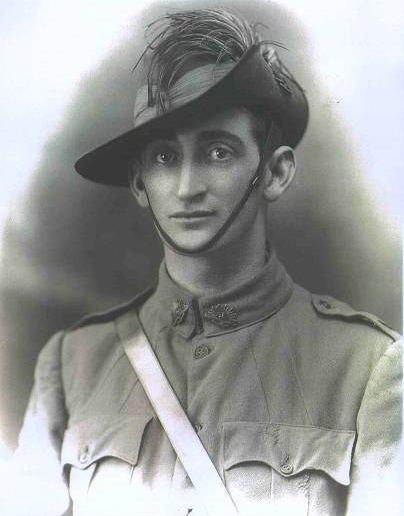 On Anzac Day we share the story of a Ballarat boy who served in World War I and would return to not only train two winners in the famed Melbourne Thousand but be a dual-code Group 1 champion.
On Anzac Day we share the story of a Ballarat boy who served in World War I and would return to not only train two winners in the famed Melbourne Thousand but be a dual-code Group 1 champion.
Noel Ridge, of Bendigo Harness Racing Club's History and Memorabilia Collection, shares George Daniel's pre and post-war story.
George Daniel was born at Happy Valley, near Ballarat. The family then moved to Scarsdale. He completed his secondary education at the Ballarat Continuation School after which he became a student teacher. His first school as a qualified teacher was at Foster in Gippsland.
George played football and cricket in his early life, however, his greatest love was cross country running, a sport he distinguished himself in by winning many medals and trophies.
In September 1914, George enlisted in the 8th Light Horse Regiment and saw service at Gallipoli and Egypt. It was while he was in Egypt that he was wounded and gassed.
On his return to Australia, he was appointed to Camp Hill School Bendigo. This move was because of central Victoria’s milder climate, which would benefit his health. To travel to school he drove his horse and gig, stabling the horse at the old Bendigo Showgrounds, now the Tom Flood Sports Centre, adjacent to Camp Hill School.
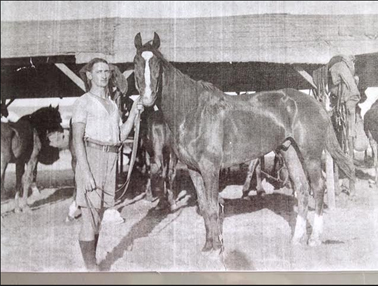 The gig horses were fit enough to race. His first race entry was Directina at Elmore in 1921. Directina, “D.George”, finished 6yj in the Ladies Bracelet.
The gig horses were fit enough to race. His first race entry was Directina at Elmore in 1921. Directina, “D.George”, finished 6yj in the Ladies Bracelet.
After a short time, George brought a property in Napier Street in White Hills, and built stables there. Napier Park Funerals now occupies the site. It was from these stables that he commenced to train a team of trotters and pacers.
Picture: George Daniel with his Light Horse Regiment troop horse Scarsdale
During these early years at White Hills, George developed a friendship with Wally Watts, a farmer at Kamarooka. George and Wally worked a system of spelling horses on Wally's farm. George would take the horses to be spelled tied to the gig, and meet Wally half way, just past Huntly. Wally would have the horses returning from a spell tied to his gig, and they would change over at the half way mark.
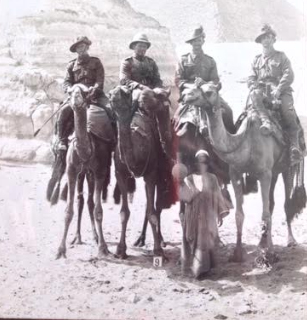 George trained the horses on the roads, only taking them to the Bendigo Jockey Club’s Epsom Racetrack for their fast work.
George trained the horses on the roads, only taking them to the Bendigo Jockey Club’s Epsom Racetrack for their fast work.
Picture: George Daniel in Egypt during WW1
As a school teacher, he did not want it known that he owned, trained and drove trotting horses, therefore, he used the "nom de plume" D George. Many of his training and driving successes were under this name. In a race at Epsom (Bendigo) he trained the winner, while also coming in second last of 22 starters with Percy Direct which he trained and drove.
BENDIGO JC (Epsom) 17-05-1928 TROT – 65 pounds - One & quarter miles
1. W Watts brm6 CISSIE VOYAGE, 54yds (H Toomer)
2. WA Andersons bg6 High Bells, 24yds (R Cox)
3. J Watts brm5 Bronte Bells, 12yds
(Winner trained by D George)
Others: Surprise Journey, scr (P Glasheen), Swift Voyage, scr (J Hawkins), Valmai Chimes, scr (D McInnes), Gracie Mauritius, scr (T Appoo), Peter Direct, 6yds (L Pascoe), Lyngar Chimes, 6yds (O Robertson), Derby Style, 6yds (H Hargreaves), Miralway, 6yds (F Donaldson), Woodway, 6yds (J McVey), Boxwood, 96yds (D Mann), Murray King, 12yds (J Farrell), Gay Ocean, 12yds (G Nelson), Nipper Siam, 18yds (J Rousch), Hammil Voyage, 30yds (D Hughes), Scottish Style, 36yds (W Lea), Rowdy Mac, 36yds (H O’Connor), Emmie Direct, 42yds (C Caldwell), Percy Direct, 72yds (D George), John Direct, 108yds (G Burton)
Margins: 6yds X 3ydsTime: 3m 2 1/2s
Transporting horses to races was a problem in the early days of trotting, and horses were either driven in harness, led from a horse and gig to the town where they were to race, or were taken by train.
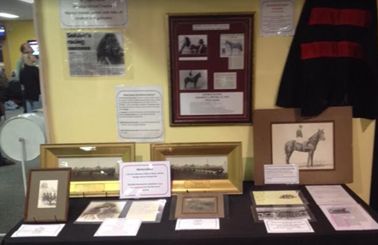 Initially, George Daniel used the train from Bendigo. However, during the war years (1939-45) he obtained a horse truck and in company with local trotting trainer Jack Wilson, transported his horses all over the east coast of Australia.
Initially, George Daniel used the train from Bendigo. However, during the war years (1939-45) he obtained a horse truck and in company with local trotting trainer Jack Wilson, transported his horses all over the east coast of Australia.
George trained over 100 trotting and pacing winners. Among them were Percy Direct and Diana Wood (both winners of the Richmond Thousand 1928/29), Blue Chip, Prince Pirate, Queen Pirate, Tennessee Direct (a problem horse who would savage anyone who came near), Bingen, Constellation, Forward, Blue Chimes, Belle Bronte, Cissie Voyage to name a few.
Picture: Display of George Daniel’s Memorabilia at Lord’s Raceway, Anzac Day meeting 2016
His first winner was the unhoppled Sunraysed with a double at Ballarat Miners Racecourse on 3rd January 1922. George Daniel’s next winner, Val Rosa, was one of his favourites, but had to be tragically put down after it broke a leg the week following the horse’s win in the 1923 Bendigo Jockey Club Open (for trotters and pacers) . With George in the saddle Val Rosa gave a start and a beating to future champion Glide Away and the classy Landstar on 23rd August 1923.
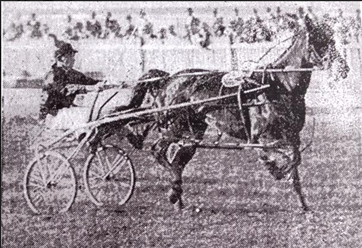 Picture: Diana Wood, winner of the 1928 Richmond Thousand
Picture: Diana Wood, winner of the 1928 Richmond Thousand
Daniel also trained Tennessee Direct USA, imported by Adelaide Hill Stud proprietor Robert Matchett. A very difficult horse to handle, Tennessee Direct was to stand stud at Adelaide Hill, and later at Dalton NSW (the home of Walla Walla) where he became the sire of Miss Mirth, the second dam of the champion 1969 Miracle Mile, and Bendigo Cup winner Adaptor, and the dam of 1954 Adelaide Inter Dominion winner Tennessee Sky.
Changing Gaits
After successfully training trotters and pacers George changed gaits, focusing on training gallopers from his White Hills stables.
He obtaining his VRC trainer’s license for the 1934/35 season. His first winner at Flemington was Cathbar, who stormed home from last to win the 1953 Braeside Handicap.
Other gallopers of note trained by George Daniel included Caxton (Ballarat Cup), the sprinter Charltonian (Provincial Cup), Gay Rocket (Kerang Cup - twice), Oswald (Bendigo Cup, Woodend Cup), Royal Symbol (Ballarat Cup), Get Sweet (Kerang & Echuca Cup), Austral Image (Donald, Ararat & Tatura Cups), Resistance (Woodend Cup), Gay Darlin (Tatura Cup) and Repel (Kerang Cup).
Greater honours in the thoroughbred field were to come, with the champion Sailors Guide, which won the G1 Victoria Derby, Craiglee Stakes (twice), Queen Elizabeth Stakes (defeating Prince Darius and Tulloch, G1 Sydney Cup, G1 AJC St. Leger and L.K.S. McKinnon Stakes.
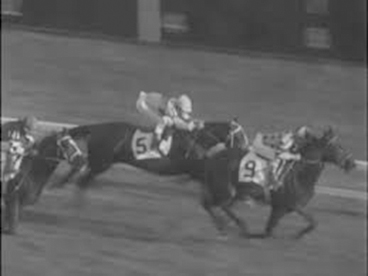 Sailors Guide won more than £100,000, with Tulloch and the New Zealand pacer Caduceus the only other horses bred in Australia or New Zealand to have achieved that distinction at that time.
Sailors Guide won more than £100,000, with Tulloch and the New Zealand pacer Caduceus the only other horses bred in Australia or New Zealand to have achieved that distinction at that time.
Picture: Sailors Guide (pictured second) won the 1958 Washington International on protest
Sailor’s Guide was exported to North America and won the prestigious 1958 Washington, D.C. International and he was once the richest Southern Hemisphere thoroughbred of all-time.
George Daniel held a VRC trainer’s licence right up until his death in 1976.
Did You Know?
George Daniel holds a unique record of training Group 1 winners in both harness racing and thoroughbred racing.
The pacers:
Percy Direct: 1928 Melbourne Thousand
Diana Wood: 1929 Melbourne Thousand
The galloper:
Sailor’s Guide: VRC Derby (1955), VRC St Leger Stakes (1956), Sydney Cup (1956), VRC Queen Elizabeth Stakes (1956), C.B.Fisher Plate(1956), Craiglee Stakes (1956, 1957), AJC St Leger (1956), Sandown Classic (1957), LKS MacKinnon Stakes (1957), Blamey Stakes (1957), P J O'Shea Stakes(1958), Blamey Stakes (1958); USA: Washington, D.C. International Stakes (1958); Canada: Jockey Club Cup Handicap (1959).
Compiled by Noel Ridge with the assistance of George Daniel’s grandson Morris Hesse, and The Trotting Annals of Bendigo and Environs, by John Peck, a digital resource at the Goldfields Library, Bendigo.